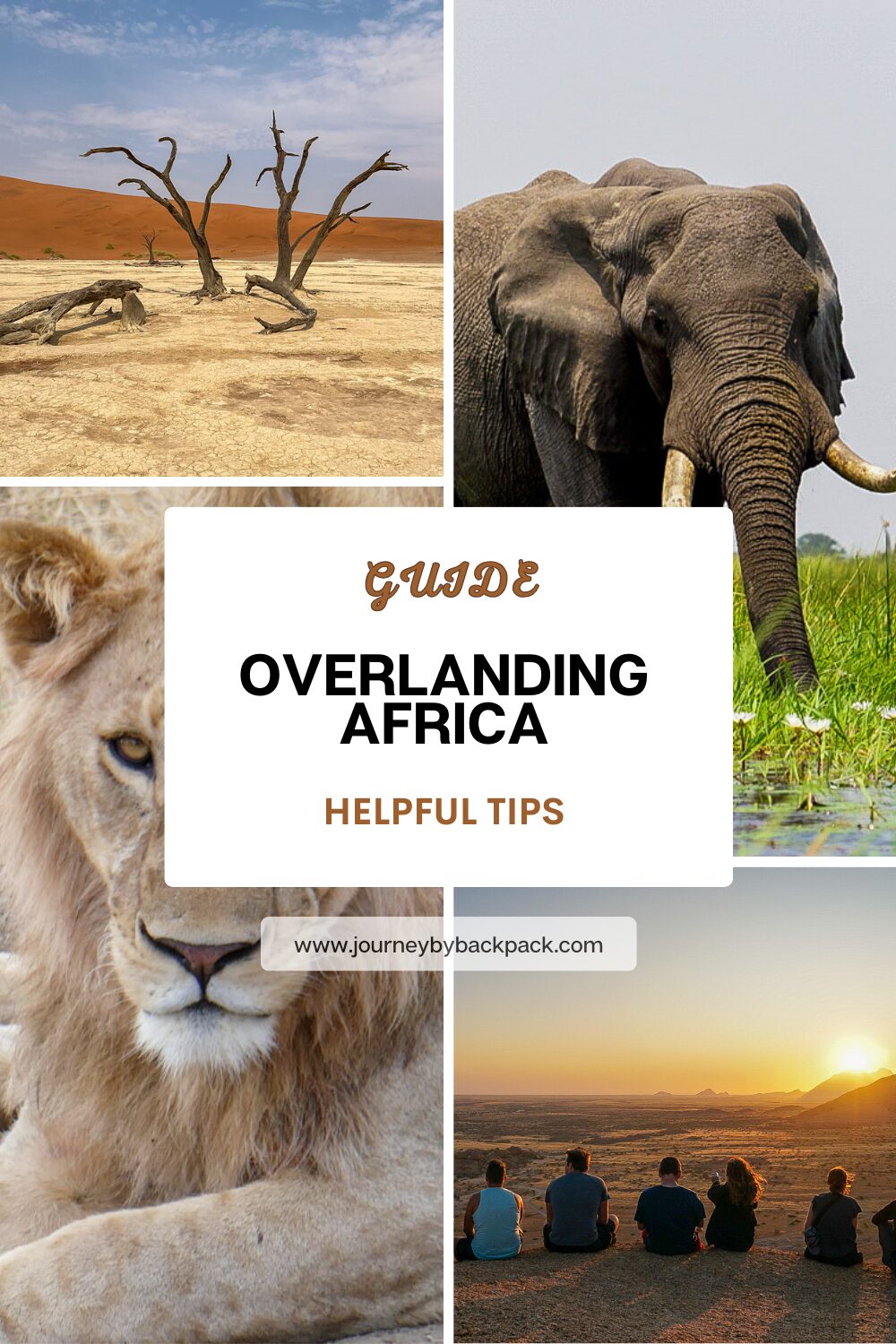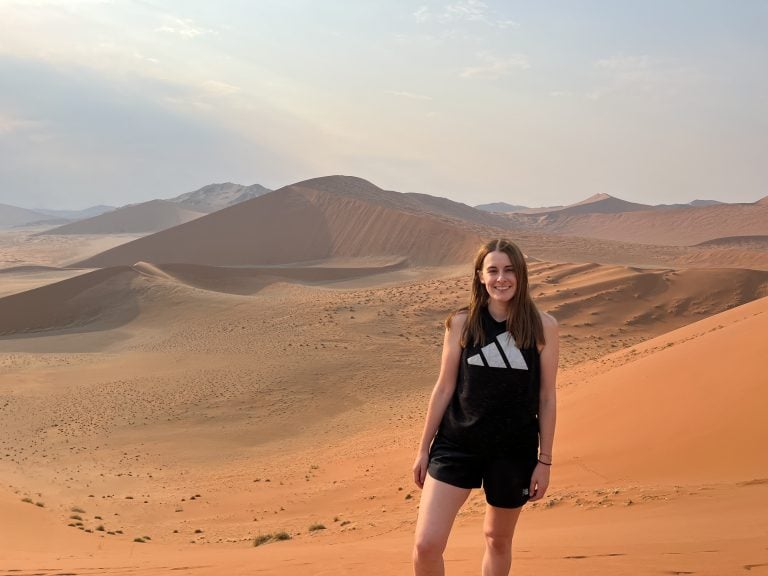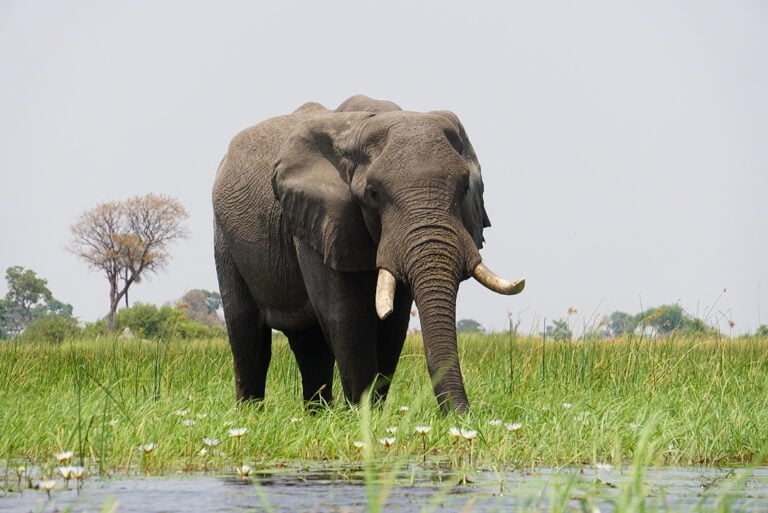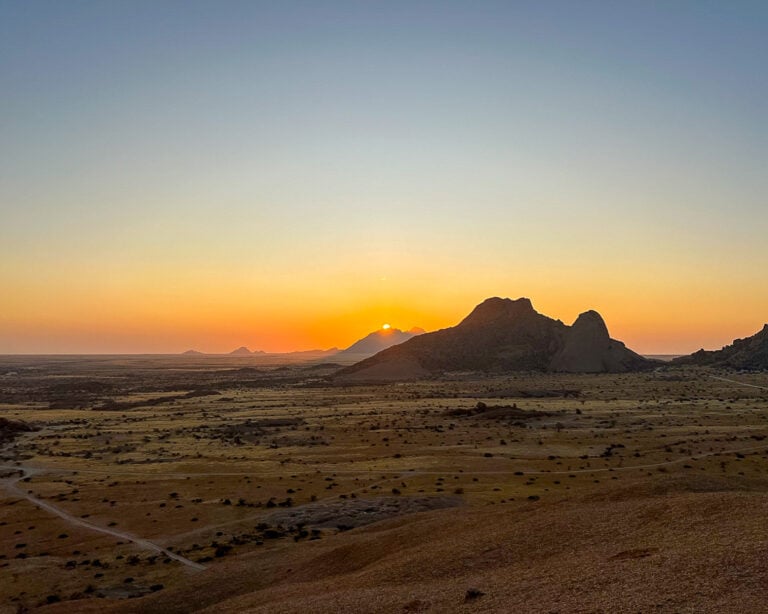Overlanding Africa: 25 Helpful Things to Know (G Adventures)

One of my favourite trips I’ve ever taken is my 55-day overlanding tour across Africa which took me to nine different countries (plus a day trip to Rwanda).
In my opinion, overlanding Africa is the best way to experience this diverse continent. From visiting some of the most famous national parks, camping under the stars, climbing sand dunes in the desert, hiking to see the famous silverback gorillas, and relaxing on the shores of the Indian Ocean, an overlanding trip across Africa is a life-changing experience.
I opted to do my trip with G Adventures who offer a range of tours across Africa, including several overland tours.
Here, you’ll find all the things I wish I had known before overlanding Africa plus some helpful tips. This is based on my experience with the fantastic G Adventures, but most points are relevant to any overlanding trip!
About Africa overland trips with G Adventures
G Adventures is one of the world’s biggest small group tour operators. I’ve travelled with them over ten times and have never had a bad experience.
So, what’s an overland trip? Put simply, an overland tour is an adventure to off-the-beaten-path destinations. It’s very much about the adventure and experience as much as it is about the places you visit. Most overland tours involve driving in a specialist overland vehicle and camping at basic campsites. They’re all about pushing you out of your comfort zone.
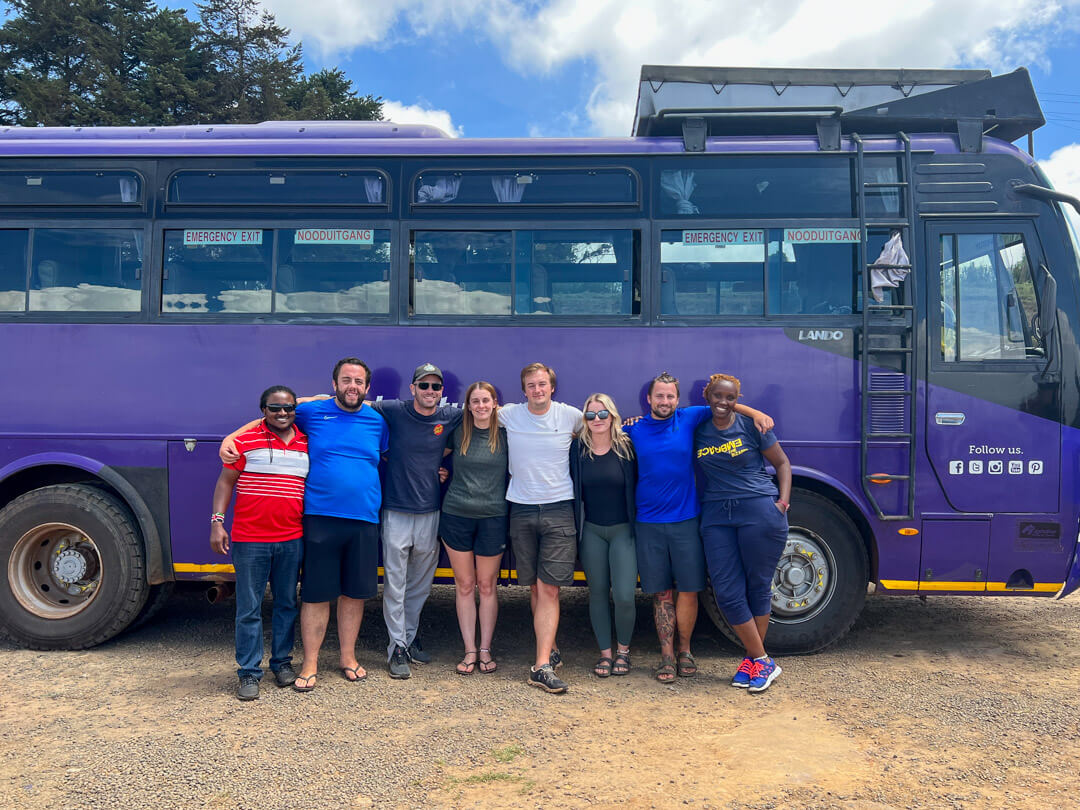
G Adventures offers several overlanding tours in Africa. I opted for the full 55-day tour, which is made up of several shorter tours. The trip was split into several legs and the group changed at the end of each one:
- Cape Town to Windhoek
- Windhoek to Victoria Falls
- Victoria Falls to Nairobi
- Nairobi to Uganda (including the famous Gorilla Trekking)
Only six of us stayed for the full 55 days. While it was challenging at times, I’m so glad I chose to do the complete tour.
In terms of inclusions, all accommodation is included in the cost of the tour. Aside from the odd night here and there, this is camping at basic campsites. Many meals and activities are also included (but you will need to pay for some meals and extra activities).
The tour included many bucket list items, including going on safari in National Parks such as the Serengeti and Masai Mara, seeing the Silverback Gorillas, looking for Chimpanzees, visiting the beautiful Zanzibar and exploring the shores of Lake Malawi.
The tour is especially good for solo travellers. Travelling across Africa without a tour is a challenge, but doing it by yourself would be even harder.
You can see all of the tours G Adventures offer in Africa here.
👉 Check out my full G Adventures review

Important things to know about overlanding in Africa
Here are some things to know about travelling across Africa overland. While the below is based on my experience with G Adventures, most points are relevant for anyone looking to do something similar with another company.
There are some long driving days
Whichever overland trip you choose, there’s guaranteed to be some long driving days. The G Adventures overland trips cover huge distances, and unfortunately, this means you’ll spend a lot of time on the road.
The longest day for us was 18 hours, but there were regular days involving 10-12 hours of driving. This was especially true for the Victoria Falls to Nairobi and Nairobi to Uganda legs.
Once you begin your trip, you’ll quickly become acquainted with the Lando, G Adventures’ answer to an overland adventure vehicle. The Lando is a large bus specifically designed for overlanding across Africa. It has everything you need, including filtered water, seat belts, storage for all your luggage, and giant windows to admire the African landscapes. (Sadly, there are no toilets!)
If you’re planning to do the full 55-day tour across Africa, the Lando will become your second home.
If you’re like me and love road trips, you probably won’t mind. As boring as it can sound, sitting and watching the ever-changing landscapes of Africa and driving through the local communities was actually a wonderful experience. With all the early starts and late nights, the long drives are also a great time to catch up on some sleep. ‘Sleep, snack, repeat’ became our motto for the long driving days.
Consider taking some entertainment with you for the driving days. Most people would have music or films downloaded, as reading a book isn’t the most fun on a bumpy road. The Lando has charging points too which is very handy.
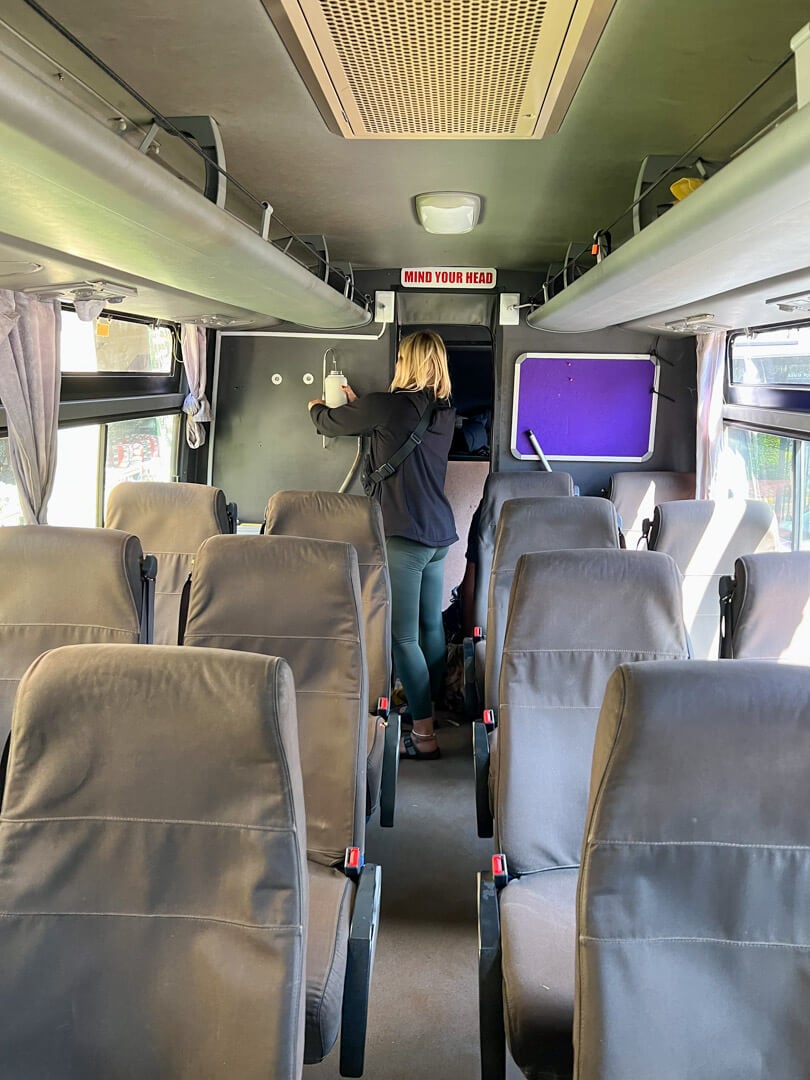
Another thing to know is that the roads can be very bumpy and the journeys can sometimes be uncomfortable. Once we left Victoria Falls and headed into Zimbabwe and Malawi, the drives became very uncomfortable as we travelled over a lot of rough terrain. You soon get used to it and it almost rocks you to sleep at times.
As the Lando has to work extra hard to drive on rough roads or up long hills, the air conditioning often has to be turned off. Luckily, with the windows open it wasn’t too bad, but the journeys weren’t always the most pleasant.
The long journeys on the Lando are all part of the Africa road trip, and it’s one of those things you just need to embrace. Overlanding Africa isn’t meant to be comfortable.
You’ll be going off-grid
It goes without saying that many African countries don’t have the best infrastructure. This means there will be times when you have to go off-grid and lose connection with the outside world.
There’s sometimes the option to buy a SIM Card or eSIM, but it’s not always the easiest to set up. As you’ll be travelling through so many countries over a short period of time, figuring out how the SIM cards work in each country can be time-consuming and expensive.
Some of the campsites have WiFi (normally at an extra cost), but with 20-odd people trying to use it at once, it’s not the most reliable.

Get used to camping
If you’re overlanding in Africa, you’ll likely spend most of your time camping. I camped consistently for 55 days straight (except 2 nights in Zanzibar), and wow, it was an experience. Whichever trip you choose, you can expect to camp in a variety of environments, including basic bush camps, the desert, the beach, and the middle of towns.
Camping for a long period of time certainly takes some getting used to, but after a week or so, it became second nature. I had some of my best night’s sleep ever in that tent!
G Adventures provides a tent and sufficient sleeping pad, but you’ll need to take your own pillow and sleeping bag. I found I didn’t need to use my sleeping bag that much and instead used my sleeping liner. This was mainly due to the hot weather (there were only a few colder nights).
If you’re a solo traveller like me, you’ll be partnered with another solo traveller for the duration of the tour. You’re responsible for putting your own tent up and taking it down every single day. Don’t worry if you’ve never done it before, the guides will show you exactly what to do (and it’s really easy).
Most campsites offer upgrade options, normally basic cabins or even dorm rooms. These come at an additional cost that ranges from $5 USD to $50 USD per night. Personally, I didn’t see the point of upgrading. The rooms were rarely that nice, and it seemed silly to pay extra money when I’d already paid for the campsites as part of the tour cost.
Of course, each to their own! Some people find sleeping pads uncomfortable, and setting up your tent day in and day out does become exhausting. Towards the end of the trip, we also caught the start of the rainy season, and camping in the rain wasn’t exactly fun! I completely understood why some people chose to upgrade.

You need to muck in and be a team player
Although you’ve paid to be on a tour and will have two experienced guides, you’re still expected to muck in. Overlanding Africa is no easy task. Each day, tents need to be put up and taken down, the Lando needs to be packed up, meals need to be cooked, dishes need to be washed and the Lando needs to be cleaned.
Everyone is split into teams and each day, each team has a different responsibility. I was quite surprised at how many people ignored this and did their own thing. G Adventures (and other companies) make it very clear that you’ll need to muck in. It’s not fair for the guides to do everything, especially when they’ve been driving all day.
Be prepared to help out every day, whether it’s cooking, cleaning or packing. It’s all part of the African overland experience.
Don’t expect warm showers
Most of the campsites have showers, but they are rarely warm.
I went almost three weeks straight without a warm shower. Luckily, with the hot weather, this wasn’t too painful.
My biggest packing tip for a road trip through Africa is to PACK WET WIPES—simple baby wipes will do. With all the dust and muck, you’re going to get dirty, and showers aren’t always a viable option. Have some wet wipes to hand for when you can’t shower or want to clean up quickly.

The campsites vary in quality
If you’re overlanding Africa with G Adventures, the entire trip will be camping (except in Zanzibar and Swakopmund). The campsites on the trip really vary in quality. Some have great facilities, a swimming pool, and even a bar. Others are very basic bush camps with little or no facilities whatsoever.
One of my favourite memories from my trip to Africa is camping in the Okavango Delta. The Okavango Delta in Botswana is one of Africa’s best safari experiences. You travel through the waterways in a dugout canoe and your guides find a place to wild camp.
This is bush camping at its finest. There are literally no facilities, not even a toilet. Your guides from the local community will find a basic bush camp spot based on where they think is suitable. This is normally away from any dangerous wildlife in the area. In the evening, you head out on a walking safari. It’s one of the best things I did on my trip!
Several other campsites on the trip also had limited facilities. This included our night in Spitzkoppe and camping in the heart of the Serengeti.
On the other hand, some of the campsites felt like luxury (especially after the basic campsites). One of my favourite campsites was in Zambia close to South Luangwa National Park. The campsite had a bar, pool, great facilities and was on the river banks where we could watch elephants and hippos (elephants even walked through our campsite).
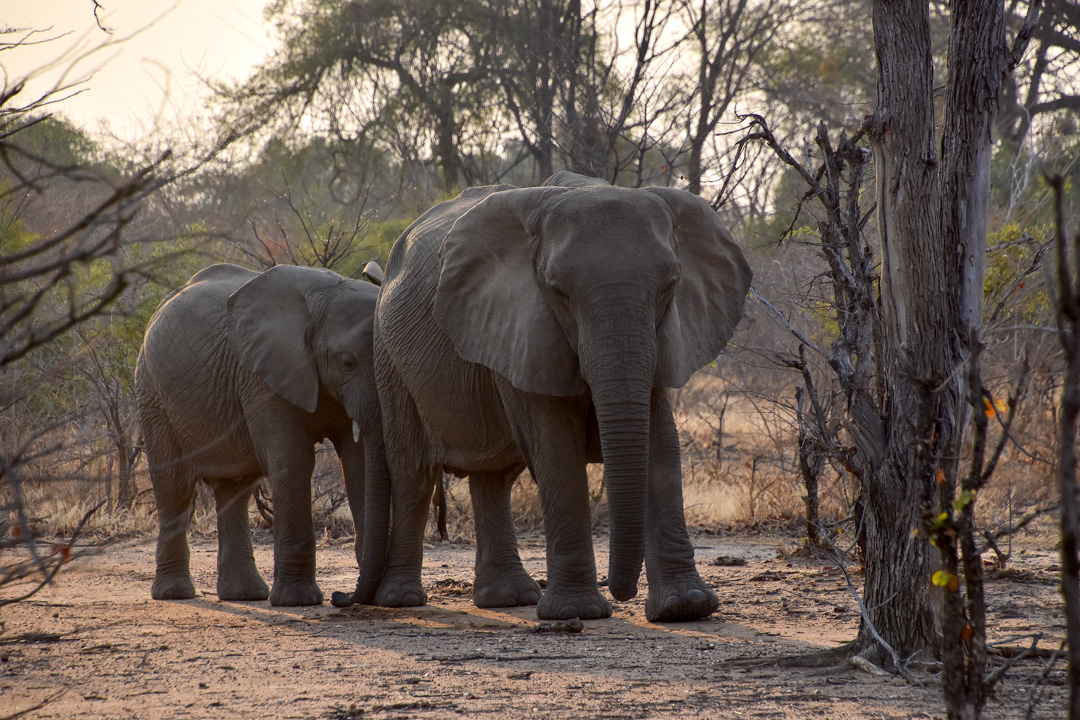
Budget for extra activities
While the trips with G Adventures tend to include a lot of activities, you’ll no doubt need to budget for some more. The 55-day overland trip included all the main highlights, such as trekking with the gorillas and safari highlights like the Serengeti and Masai Mara.
However, a few tours and activities were not included. For example, if you wanted to explore Etosha in Namibia in a safari vehicle, you had to pay extra. The same was true for Chobe National Park and the Chobe River Cruise (one of the best activities I did on the trip).
There’s no pressure to pay for the activities, and you necessarily have to do all of them (I certainly didn’t). But some were really worth doing. These include the Chobe Sunset River Cruise, sand boarding in Namibia, a boat trip in Zanzibar, and a day trip to Rwanda.
If you want to tick off some bucket list experiences, you can fly over the Okavango Delta or ride a hot-air balloon at sunrise over the Serengeti (with a champagne breakfast). There were people in the group who did these activities, and they only had good things to say. Sadly, my budget didn’t stretch this far, but I’d love to return one day for the hot-air balloon ride.

The early bird catches the worm
If you’re a night owl who enjoys sleeping in, you’re going to be in for a shock on this trip. Most days start early, really early!
We had lots of 4/5 am starts, and most days involved being on the road by 7 am. Sadly, you can’t just roll out of bed on this trip. You have to pack down your tent, make breakfast (and often your lunch) and pack up the Lando which takes a good hour.
I think I can count on one hand how many days we were able to sleep in past 7 am. This was normally only when we were in the same place for more than one night (which is also a rare occurrence on the trip).
The good news is the Lando is perfect for sleeping! The seats recline, there are curtains, and the bumpy roads rock you to sleep. You soon get into a routine.
The benefit of getting on the road early is that you’ll have plenty of time to explore during the day. It also means you’ll arrive at your next campsite in daylight, which will make putting up the tents a bit easier.
It can be a shock to the system at the start, but it’s well worth it and you soon get used to it.
It can be exhausting
Following on from the above point, the trip can be tiring, both physically and mentally.
While the trip isn’t always the most physical (you’ll be sat down a lot), you’re still pushing your body in other ways. Firstly, camping consecutively for up to 55 nights isn’t exactly relaxing. You’ll be camping in hot weather, cold weather, heavy rain and sand storms.
Then there are the early starts and the constant packing up and moving on, only to unpack and put the tents back up a few hours later. All of this takes its toll on the body.

I personally found the trip more mentally challenging than I had anticipated. All of the above points, plus the basic campsites, extreme weather, and lack of facilities, took their toll, especially towards the end. But this is what overlanding Africa is all about!
Would I change anything about the trip? Absolutely not. I loved every second of it despite its challenges. This type of trip isn’t just about visiting all of these amazing places on a holiday. It’s about pushing yourself out of your comfort zone and experiencing the adventure of a lifetime.
The beauty of G Adventures is that they offer various overland tours of different lengths. If you think 55 days might be too much, there are options for shorter tours.
Prepare for ‘bushy bushy’
‘Bushy bushy’ is a phrase you’ll no doubt get used to while overlanding in Africa. It’s basically the polite way of saying ‘peeing behind a bush’.
The first part of the trip (South Africa, Namibia and Botswana) has regular toilet stops at modern gas stations (great spots to top up the snacks). However, after leaving Victoria Falls, the bathroom situation changes.
There are not many places to stop for the toilet, and the gas stations that do have toilets aren’t always the most appealing. You’ll no doubt find yourself peeing behind a bush several times a day on the trip.
It can be tough at first, but you soon get used to it when it’s your only option! Everyone is in the same position as you, and as I’ve said several times already, it’s all part of the experience!

Watch out for wildlife
It’s no secret that Africa is home to some incredible wildlife and offers some of the best wildlife encounters on the planet. The G Adventures trip really gets you close to wildlife by including several safari experiences including the famous Gorilla trekking.
However, one thing I wasn’t prepared for was how many day-to-day encounters we would have. We experienced elephants wandering through our campsite, zebras outside our tents, hyenas rummaging through our bins, and elephants outside a bar in Victoria Falls. And let’s not even start on the baboons.
It might sound silly, but in my mind, these wildlife encounters were only possible when on safari. Not when leaving a bar in the middle of a busy town. How wrong was I?! Zimbabwe, Zambia, and Malawi especially got us closer to wildlife than I could ever have imagined.
While this is absolutely incredible, it’s important to be aware of your surroundings and not take any risks. It’s probably not the best idea to leave your tent if you know there’s a potentially dangerous animal there. Likewise, if you need the toilet in the middle of the night, check the area before leaving the tent and let your tentmate know.
The baboons, in particular, were an absolute nightmare (in a hilarious way). They terrorised us at several campsites, trying to snatch food and even coming into our tents to steal things. Luckily, the guides were well-versed in keeping the baboons away.

One thing we learned very early on in the trip is not to leave your shoes outside the tent. If you do, you’ll probably never see them again. Several animals will take them, and some people in my group had to learn the hard way.
It’s not just large animals to be aware of. Africa is home to several dangerous species of spiders, snakes and scorpions. If you’re out and about at night, make sure you have a head torch so you can see exactly where you’re walking. If you did happen to leave your shoes outside and they survived, check for any creepy crawlies inside before wearing them.
Plan your border crossings and visas
Before embarking on your trip, check out the visa situation for every country you’re planning to visit. It’s entirely your responsibility to make sure you have all the correct documentation, and G Adventures can’t help you with this.
As I’m from the UK, most of the visas were quite straightforward for me. However, I did need to get a couple of visas in advance, including Malawi and the East Africa visa (this allows entry between Kenya, Uganda and Rwanda).
A few people were caught off guard by visa restrictions and not having applied in advance. Thankfully, the guides were always able to help and sort things out, but it’s still a sensible idea to research in advance.
If you’re doing the full 55-day tour, you’ll be doing more than ten border crossings. The border crossing days were always my least favourite as the borders were often chaotic and involved a lot of queuing. Just mentally prepare for these days as much as you can. The guides were always amazing at organising everyone.
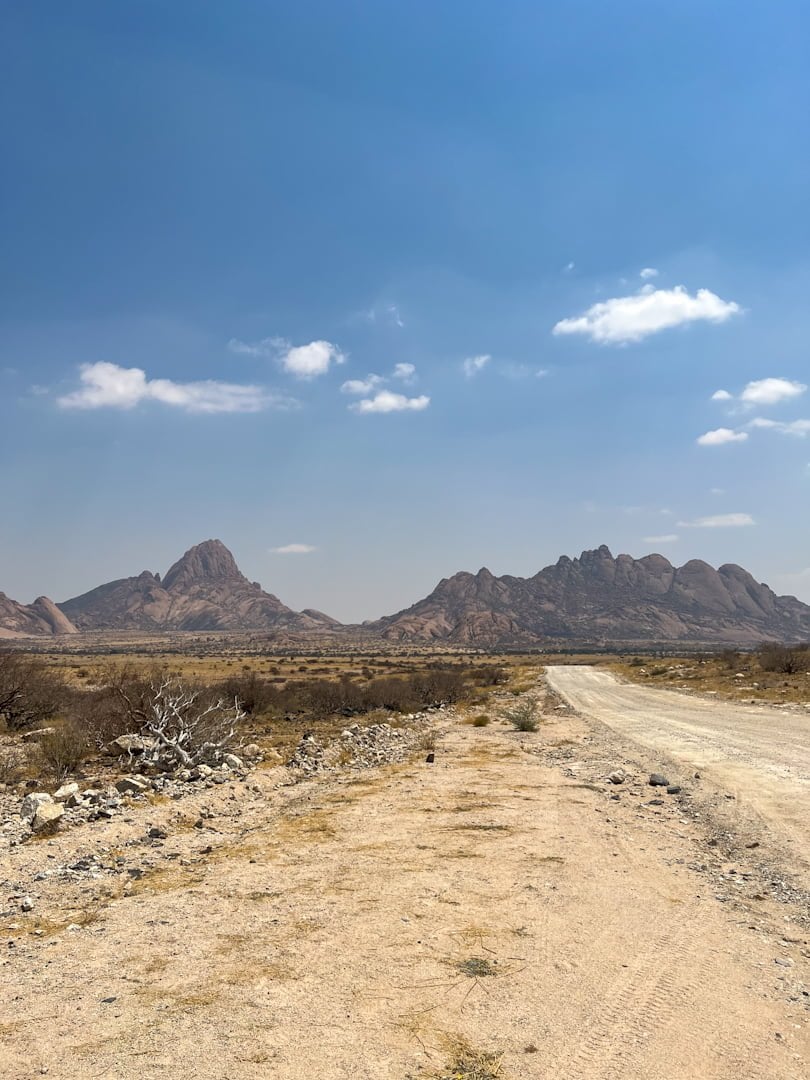
The group and guide may change several times
As I mentioned above, the full G Adventures overland tour consists of several shorter tours. This means that the group and guides will regularly change.
We had four different group changes throughout the two months. Only six of us were crazy enough to do the full 55 days! The bond I made with these five other people was like no other. We became like a family (as cringeworthy as it sounds), but you genuinely go through so much together in such a short space of time.
Each group has different dynamics. Just as you are getting into a routine, the group will change, and you will have to start from scratch. At one point, the entire group left (apart from the six of us doing the full tour), and 16 new people joined.
If you’re unsure about how this will affect your trip, you can contact G Adventures so you know exactly if and when the group might change.

Pack lightly
You’re going to be on the move a lot so try to pack as lightly as possible. Backpacks are kept in the tents overnight and loaded onto the Lando every morning. As you move on almost every day, keeping your backpack as light and as easy to pack as possible is a good idea.
If you’re torn between a backpack and a suitcase, go for the backpack! Lifting a suitcase onto the Lando is not fun, and it’s going to be a pain to keep inside your tent. Someone on my tour brought a huge suitcase with them and it took up so much space.
There are places to do laundry every few days, so stick to packing only what you need.
Your clothes will be destroyed
Okay, destroyed might be a bit dramatic, but your clothes are going to get very dirty on the trip. I don’t recommend wearing anything that you want to keep in top condition. I came back with a suitcase full of dusty clothes with rips and holes!
I ruined my shoes while Gorilla trekking and ripped a hole in my trousers while Chimpanzee trekking.

It’s great for solo travellers
Joining a group tour anywhere in the world is a great option for solo travellers, but this tour is particularly great.
Over the two months, aside from several couples, the majority of people were solo travellers. Group travel is a great way to meet people and relieves the stress of having to organise everything yourself.
The people I met on the tour became like family and I made friends for life. It’s the perfect tour for solo travellers, so don’t be worried.
It’s generally safe
When I told people I was heading to Africa for two months, the first response was normally, ‘Is it safe?’. As with many regions in the world, various African countries have their issues, especially regarding safety.
However, the countries visited on the G Adventures trip are generally quite stable and visited by thousands of tourists every year. Granted, the trip does take you well off the beaten path through places like Zambia and Malawi, but G prioritises safety above everything else.
I never once felt unsafe on the trip and found all the locals to be more than welcoming. I’d be lying if I said there were never any risks, but measures were always taken to keep the group safe. Many campsites had armed security guards who patrolled the campsite throughout the night as a precaution. Some campsites were also gated with high fences.
It’s worth noting that this was sometimes to protect the group from dangerous wildlife as much as anything else.
Don’t let safety concerns put you off from joining the trip. G Adventures and other overland companies are well-versed in keeping the groups safe.

Enjoy home-cooked meals
I was blown away by the food included in the tour. I was expecting to live off basic pasta, toast, and ramen noodles, but I couldn’t have been more wrong.
Most of the meals on the tour are included (although you will need to pay for a few). Breakfast normally consists of eggs, toast, cereals, fruit, and yoghurt. Most of the time, lunch is a sandwich or leftovers from the night before.
Dinner is where things got interesting. From Cape Town to Victoria Falls, we had a lot of Braai (Barbecue), burgers, and steaks. Once we headed into Eastern Africa, the meals were a lot more focused on pasta, lentils, and beans. There were always fresh vegetables available and plenty of food to go around.
I’m sure the guides influenced the menus, but the food was delicious.
When meals aren’t included, it’s normally because you’re in a place where there are lots of nice restaurants to try, such as in Victoria Falls.
There are also regular stops at supermarkets to top up the food and also your own personal snack supply (trust me, you’ll need snacks for those long drives)!
The guides are amazing
I’ve travelled with G Adventures over ten times now and have never had a bad experience with one of their guides. G refers to their guides as CEOs (Chief Experience Officers), as their job is to ultimately make sure you’re having the best time.
While overlanding Africa with G, you’ll have at least two CEOs. One is a driver, and one is there to manage the group and make sure everything is running like clockwork.
As the trip with G has different legs, your CEOs may change. This is what happened to me, and in total, I had five different CEOs during my trip.
The CEOs on my Africa trip were honestly brilliant. They went above and beyond to help the group. They were always awake an hour before us to start breakfast and asleep an hour after us to pack away. I’ve been a small group tour guide myself and can safely say the CEOs on this tour have a tough job, but they are absolutely brilliant.

There’s no ‘bad’ time to do the trip
The beauty of overlanding Africa is that there is no best or bad time of year to do it. Africa is a huge place, and each country has its own weather patterns and seasons. While visiting Botswana in the summer might be good, it doesn’t necessarily mean that’s the best time of year to visit Uganda or South Africa.
The truth is, there’s no ‘perfect time’ to do this trip. If you want to see something that only happens at a certain time of year such as the Great Migration, then prioritise that. However, be prepared that it may mean you’re sacrificing something else.
Another popular attraction on the tour is Victoria Falls. Generally speaking, the best time to visit is between February and May when the waterfalls are at their most powerful. I visited during the dry season and it was still spectacular.
The truth is, you’re never going to tick every box when it comes to finding the best time of year. To see one thing at its peak may mean missing something else.
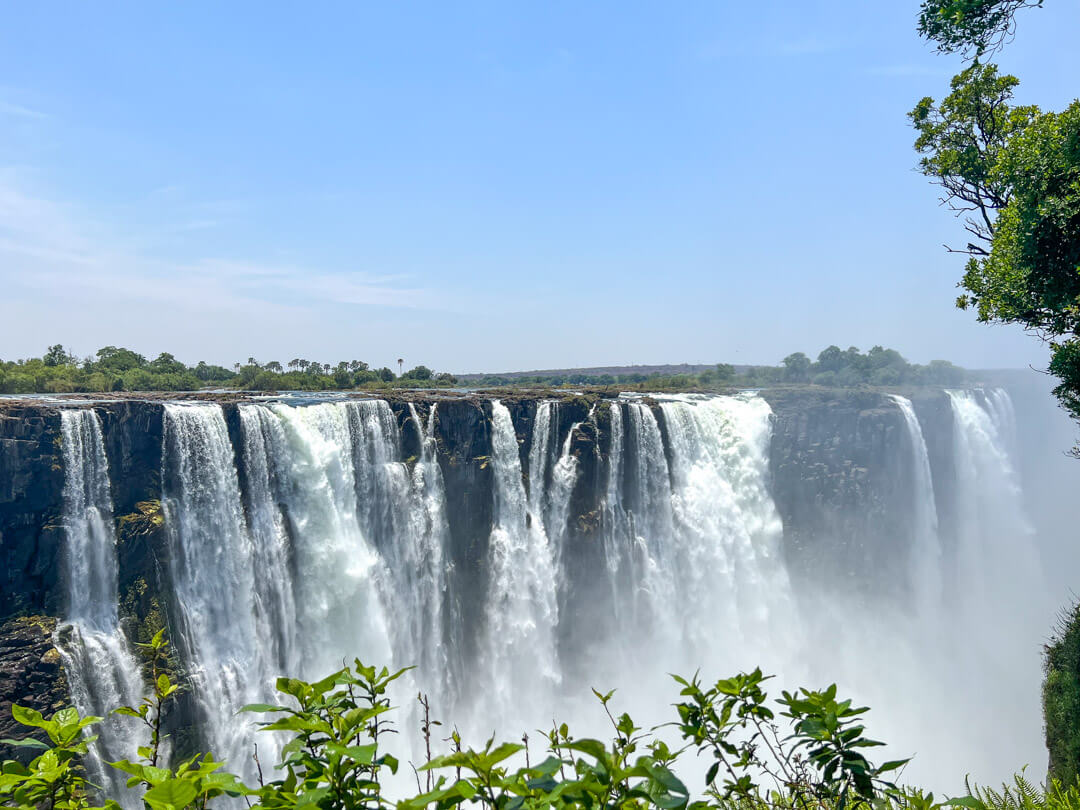
Take anti-malarials
Many of the countries visited on this trip have high rates of Malaria. Everyone in my group took anti-malarial medication, especially once we reached Victoria Falls.
Of course, whether you take anti-malarial medication is entirely a personal choice that should be discussed with a healthcare professional. However, our guides did advise that we all take the medication to prevent us from getting sick.
This will no doubt be the trip of a lifetime, and the last thing you want is to get sick with malaria.
Carry cash
You’ll need to carry cash on your overlanding trip through Africa. While accommodation, transport and most meals are covered, you’ll need cash for tipping, paying for visas, extra meals and any additional activities you want to do.
Some tourist areas did accept credit cards, but cash always seemed to be the preferred method.
Where it becomes confusing is each country has its own currency. As you’re moving through so many countries so quickly, it can be a bit of a headache working out exactly how much money you need. Thankfully, the guides are great at giving advice on this. Most of the borders also have places to exchange currency at a fair rate.
I’d suggest also carrying some USD. Some of the borders required us to pay a fee and they would only accept USD. Many of the tour operators also preferred USD.
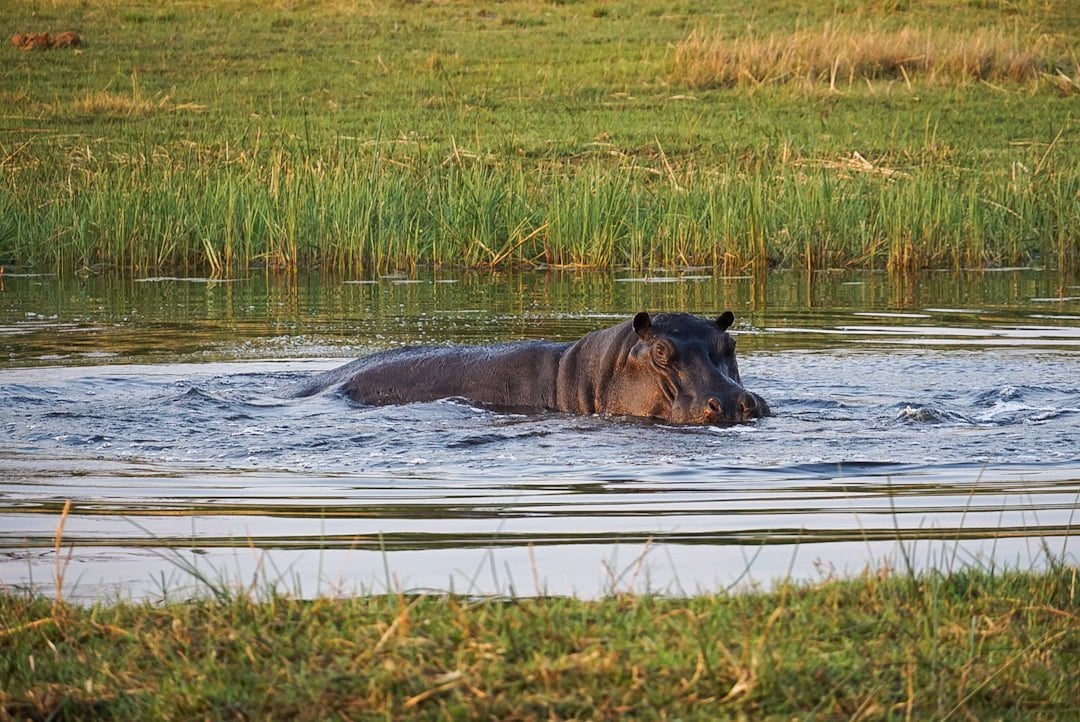
Be respectful of local people
You’ll encounter many different communities and cultures on your trip across Africa. You’ll have the chance to meet and engage with local communities, try their food, and learn about their culture.
One of my favourite memories from the trip is spending the night with locals in the Okavango Delta. We danced under the stars as they shared their songs and games with us.
Cultures differ worldwide, and countries in Africa are no exception. There may be some culture shocks along the way but try to embrace these as much as you can.
There also seems to be a trend of people sharing photos of people from Africa on social media, especially children. This warrants a much bigger conversation that’s not for this post, however, remember to be respectful of locals. If you wouldn’t post a photo of a random child in the town where you live, why post a photo of a child you’ve met travelling? Children are not props for your travel photos.
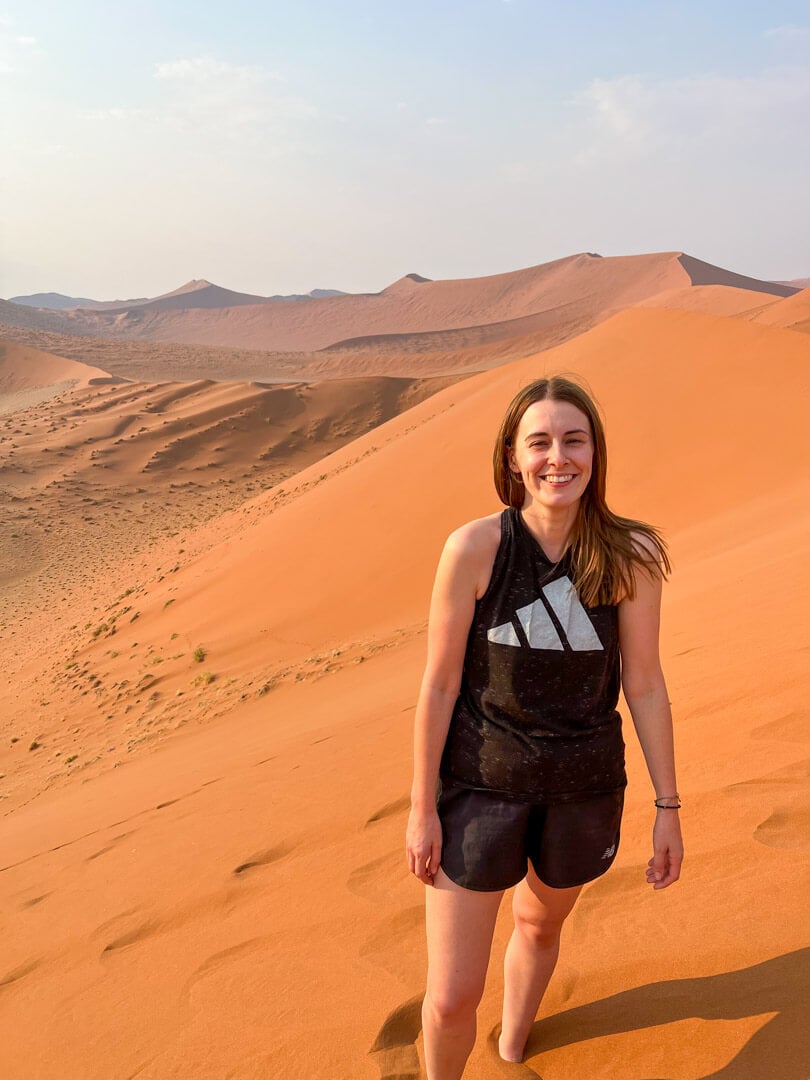
Try and embrace the adventure
If you’ve read this entire article (thank you if you have), you’ll have seen I’ve mentioned ‘it’s all part of the experience’ several times. Overlanding Africa is no easy feat. It’s the exact opposite of luxury, and you’ll be testing your body physically and mentally, especially when doing a longer trip.
Let’s be honest: How many people would be able to camp for two months straight with little to no facilities?
This trip isn’t a holiday, it’s about experiencing a part of the world that not many people have the opportunity to. It’s not designed to be comfortable. Overlanding Africa is all about the adventure.
You’ll be uncomfortable and exhausted at times, and there will be delays and changes to the itinerary.
The only thing you can do is embrace the adventure and throw yourself into it.
It’s a life-changing experience
Overlanding Africa is a life-changing experience for many reasons. From pushing yourself physically and mentally to experiencing unique cultures and having close encounters with magnificent wildlife, the trip will undoubtedly leave an impact.
My trip across Africa is my absolute favourite trip I’ve ever taken. The people I met, the experiences I had, the places I saw—I can’t quite put into words how special this trip was.
Sure, it came with its challenges, but it’s a trip I shall treasure forever. If I could go back and do this trip all over again, I 100% would.
